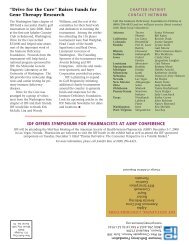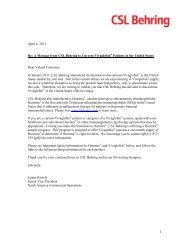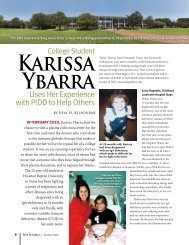IDF Patient & Family Handbook for Primary Immunodeficiency ... - IDFA
IDF Patient & Family Handbook for Primary Immunodeficiency ... - IDFA
IDF Patient & Family Handbook for Primary Immunodeficiency ... - IDFA
You also want an ePaper? Increase the reach of your titles
YUMPU automatically turns print PDFs into web optimized ePapers that Google loves.
DiGeorge Syndrome 47<br />
Definition of DiGeorge Syndrome<br />
The DiGeorge Syndrome is a primary<br />
immunodeficiency disease which is caused by<br />
abnormal migration and development of certain<br />
cells and tissues during growth and differentiation<br />
of the fetus. Different tissues and organs often<br />
arise from a single group of embryonic cells.<br />
Although the tissues and organs that ultimately<br />
develop from a single group of embryonic cells<br />
may appear to be unrelated in the fully <strong>for</strong>med<br />
child, they are related in that they have developed<br />
from the same embryonic or fetal tissues.<br />
Although many different organs may be involved in<br />
the DiGeorge Syndrome, they all evolve from the<br />
same embryonic cells.<br />
Most, but not all patients with the DiGeorge<br />
Syndrome have a small deletion in a specific<br />
part of chromosome number 22 at position<br />
22q11.2. Another name <strong>for</strong> this syndrome is the<br />
chromosome 22q11.2 deletion syndrome. <strong>Patient</strong>s<br />
with the DiGeorge Syndrome do not all show the<br />
same organ involvement. A given organ may be<br />
uninvolved, or so mildly involved that the organ<br />
appears to be normal. Thus, patients with the<br />
DiGeorge Syndrome may not all have the same<br />
organs involved or the same severity. <strong>Patient</strong>s<br />
with the DiGeorge Syndrome may have any or all<br />
of the following:<br />
Facial Appearance<br />
Affected children may have an underdeveloped<br />
chin, eyes with heavy eyelids, ears that are rotated<br />
back and defective upper portions of their ear<br />
lobes. These facial characteristics vary greatly from<br />
child to child and may not be very prominent in<br />
many affected children.<br />
Parathyroid Gland Abnormalities<br />
Affected children may have underdeveloped<br />
parathyroid glands (hypoparathyroidism). The<br />
parathyroids are small glands found in the front of<br />
the neck near the thyroid gland (hence the name<br />
“parathyroid”). They function to control the normal<br />
metabolism and blood levels of calcium. Children<br />
with the DiGeorge Syndrome may have trouble<br />
maintaining normal levels of calcium, and this<br />
may cause them to have seizures (convulsions).<br />
In some cases, the parathyroid abnormality is<br />
relatively mild or not present at all. The parathyroid<br />
defect often becomes less severe with time.<br />
Heart Defects<br />
Affected children may have a variety of heart<br />
(or cardiac) defects. For the most part, these<br />
anomalies involve the aorta and the part of the<br />
heart from which the aorta develops. As with other<br />
organs affected in the DiGeorge Syndrome, heart<br />
defects vary from child to child. In some children,<br />
heart defects may be very mild or absent.<br />
Thymus Gland Abnormalities<br />
Affected infants and children may have<br />
abnormalities of their thymus. The thymus gland<br />
is normally located in the upper area of the front<br />
of the chest. The thymus begins its development<br />
high in the neck during the first three months of<br />
fetal development. As the thymus matures and<br />
gets bigger, it drops down into the chest to its<br />
ultimate location under the breastbone and over<br />
the heart.<br />
The thymus controls the development and<br />
maturation of one kind of lymphocyte, the<br />
T-lymphocyte (“T” <strong>for</strong> “Thymus”) (see chapter<br />
titled The Immune System and <strong>Primary</strong> Immune<br />
Deficiency Diseases). The size of the thymus<br />
affects the number of T-lymphocytes that can<br />
develop. <strong>Patient</strong>s with a small thymus produce<br />
fewer T-lymphocytes than someone with a<br />
normally sized thymus. T-lymphocytes are<br />
essential <strong>for</strong> resistance to certain viral and fungal<br />
infections. Some T-lymphocytes, the cytotoxic<br />
T-lymphocytes, directly kill viruses. T-lymphocytes<br />
also help B-lymphocytes to develop into plasma<br />
cells and produce immunoglobulins or antibodies.<br />
<strong>Patient</strong>s with the DiGeorge Syndrome may have<br />
poor T-cell production compared to their peers,<br />
and as a result, they may have an increased<br />
susceptibility to viral, fungal and bacterial infections.<br />
As with the other defects in the DiGeorge<br />
Syndrome, the T-lymphocyte defect varies from<br />
patient to patient. In addition, small or mild<br />
deficiencies may disappear with time.<br />
Miscellaneous Clinical Features<br />
In addition to the above features, patients with<br />
the DiGeorge Syndrome may occasionally have<br />
a variety of other developmental abnormalities<br />
including cleft palate, poor function of the palate,<br />
delayed acquisition of speech and difficulty in<br />
feeding and swallowing. In addition, some patients<br />
have learning disabilities, behavioral problems,<br />
and hyperactivity.
















